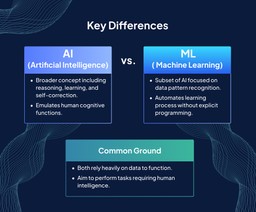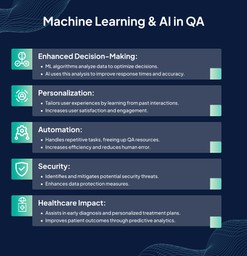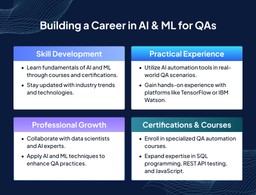In 2023, a staggering $154 billion was poured into AI-centric systems worldwide. Moreover, spending on artificial intelligence (AI) varied immensely across industries in 2023, with banking and retail taking the lead in AI investments.
As a QA, your job in any sector is to ensure every dollar spent translates into flawless, top-tier products and services.
It’s not just about testing anymore; it’s about revolutionizing quality assurance in this era of technological marvels.
To enhance your qualifications, taking a QA automation course will seal the deal.
Imagine you’ll be at the forefront of QA innovation with the top skills and knowledge of the latest automated tools.
So, strap in because we’re about to embark on a journey filled with implications, possibilities, and unparalleled excitement in the ever-evolving world of Machine Learning and AI.
Are Machine Learning and AI the Same?
Ah, the age-old comparison: AI vs. Machine Learning.
Are they two sides of the same coin or distinct entities with unique characteristics?
At first glance, it’s easy to conflate ML and AI, given their intertwined nature. After all, ML is a subset of AI, serving as the backbone that powers many AI applications.
Here are a few essential things to remember when it comes to their similarities and differences:
Similarities:
- Interconnectedness: ML is a subset of AI, meaning that ML techniques and algorithms are integral components of AI systems. Both ML and AI share the common goal of developing systems that are ready to perform complex tasks that traditionally require human intelligence.
- Data Dependency: Both ML and AI rely heavily on data. Machine learning algorithms learn from datasets to make predictions or decisions, while AI systems use data to simulate human-like intelligence and behavior.
- Continuous Learning: Machine learning models and AI systems can adapt and improve over time. ML algorithms, in particular, are designed to learn from new data and experiences, enhancing their performance and accuracy with time.
Differences:
- Scope: AI encompasses a broader range of concepts, including ML, but also other approaches such as expert systems, natural language processing, and robotics. ML, on the other hand, specifically focuses on algorithms that learn from data.
- Learning Approach: ML algorithms learn from data through pattern recognition and statistical inference, whereas AI systems may employ a variety of techniques, including rule-based systems, symbolic reasoning, and deep learning, to emulate human intelligence.
- Human-like Intelligence: While both ML and AI aim to replicate aspects of human intelligence, AI often targets higher-level cognitive functions such as reasoning, problem-solving, and decision-making, whereas ML tends to focus on specific tasks like classification, regression, clustering, and reinforcement learning.
What are the Advantages of Using Machine Learning and AI Together?
Let’s dive into why pairing Machine Learning (ML) and Artificial Intelligence (AI) is like bringing peanut butter and jelly together – a perfect match that makes everything better!
Smart Decision-Making
Imagine having a super-smart assistant that helps you make decisions based on loads of data. ML brings this to the table, teaching AI systems to understand patterns and make sense of all that information.
So, when they work hand in hand, you’re not just making decisions; you’re making brilliant ones!
Tailored Just for You
Ever noticed how some apps seem to know exactly what you want before you even do? That’s the magic of ML and AI working together.
ML learns from your past actions and preferences, while AI uses that knowledge to give you personalized experiences, whether recommending movies, clothes, or even workout routines.
Less Work, More Fun
Who doesn’t love a little automation? ML and AI are like your personal team of helpers, taking care of repetitive tasks so you can focus on the fun stuff.
From sorting through emails to spotting potential problems before they happen, they’ve got your back, making life a whole lot easier.
Keeping You Safe and Sound
Picture this: a superhero duo guarding your digital world from cyber baddies.
ML and AI work together to sniff out fraud, detect suspicious activity, and keep your data safe so you can do activities like browse, shop, and banking online with peace of mind.
Your Health’s Best Buddy
ML and AI aren’t just smart; they’re also pretty good doctors! By analyzing your health data, they can help doctors diagnose diseases earlier, tailor treatments just for you, and even predict health risks before they become big problems. It’s like having a healthy genie in your pocket!
So, whether it’s making smarter choices, personalizing your world, lightening your workload, keeping you safe online, or even looking after your health, ML and AI make an unbeatable team.
The Difference Between Machine Learning and Deep Learning
Let’s unravel the mystery between Deep Learning (DL) and Machine Learning (ML), two pillars of artificial intelligence that often get tangled together.
Think of it like this: if ML is the toolbox, then DL is one of the most powerful tools within it.
Let’s break it down:
Machine Learning (ML)
Imagine you have a bunch of data, and you want a computer to learn from it, recognize patterns, and predict or make decisions. ML is the magic that makes it happen!
It’s like teaching clever pet tricks – you show examples, it learns, and then it applies that knowledge to new situations. ML algorithms come in different flavors, like decision trees, support vector machines, and random forests, each with its own strengths and weaknesses.
Deep Learning (DL)
Now, picture ML on steroids – that’s DL! It’s a subset of ML that’s inspired by the structure and function of the human brain, using artificial neural networks with many layers (hence the “deep” part).
These networks can learn from big amounts of data, automatically discovering intricate patterns and features that might be too complex for traditional ML algorithms to grasp.
DL is behind some of the most mind-blowing AI breakthroughs, like image and speech recognition, natural language processing, and autonomous driving.
How Do Machine Learning and AI Fit into the QA World
Let’s paint a picture of how Machine Learning (ML) and Artificial Intelligence (AI) seamlessly integrate into the Quality Assurance (QA) realm, transforming it into a playground of innovation and efficiency.
Automated Testing
Imagine having an army of tireless testers at your disposal, working round the clock to identify bugs and defects in software applications.
That’s the power of AI-driven automated testing! ML algorithms can analyze vast amounts of test data, learn from past testing experiences, and intelligently prioritize test cases, significantly speeding up the testing process and reducing manual effort.
Predictive QA Analytics
ML algorithms can crunch QA metrics and historical data to predict potential quality issues before they occur.
By analyzing patterns and trends in software development and testing, AI-powered predictive analytics tools can provide valuable insights into areas of risk, enabling QA teams to proactively address potential problems and optimize their testing strategies for maximum effectiveness.
Intelligent Test Case Generation
Like genetic algorithms and reinforcement learning, ML techniques can automatically generate test cases based on requirements, specifications, and historical data.
By leveraging AI-driven test case generation tools, QA teams can ensure comprehensive test coverage and uncover edge cases that may be overlooked with manual test case creation methods.
Bug Detection and Root Cause Analysis
AI-powered anomaly detection algorithms can sift through vast amounts of code and log data to identify deviations from expected behavior, flagging potential bugs and anomalies for further investigation.
ML techniques, like clustering and classification, can also help QA teams identify patterns in bug reports and prioritize them based on severity and impact, streamlining the bug triage and resolution process.
Natural Language Processing (NLP) for Test Automation
NLP, a subset of AI, enables machines to understand and interpret human language.
By incorporating NLP into test automation frameworks, QA teams can develop natural language-based test scripts and interact with testing tools using voice commands or chatbots, enhancing the usability and accessibility of test automation solutions.
In essence, ML and AI are revolutionizing the QA world by enabling automated testing, predictive analytics, intelligent test case generation, bug detection, root cause analysis, and natural language processing.
How to Enter the Machine Learning and AI Domain as a QA
Entering the Machine Learning (ML) and Artificial Intelligence (AI) domain as a Quality Assurance (QA) professional is a journey filled with growth and innovation.
Here’s how you can embark on this path:
- Continuous Learning and Skill Development: Equip yourself with the necessary knowledge and skills to thrive in the ML and AI domain. Start by learning the fundamentals of ML and AI through online courses, tutorials, and certifications.
Dive into supervised and unsupervised learning, neural networks, and natural language processing. Stay updated with up-to-date trends and advancements in the AI field by attending QA conferences, webinars, and industry events.
- Hands-on Experience with AI Automation Tools: Familiarize yourself with AI automation tools and platforms that are commonly used in the QA industry. These tools leverage AI and ML algorithms to automate testing processes, identify defects, and optimize test coverage.
A new “Future of Quality Assurance 2023” study by LambdaTest has shed new light on software testing practices in 2023, including finding that 78% have already adopted AI. Emphasize the importance of using AI automation tools to enhance testing efficiency, reduce manual effort, and improve overall software quality.
- Collaborate with Data Scientists and AI Experts: Build strong relationships with data scientists, AI engineers, and other professionals working in the ML and AI domain. Collaborate on cross-functional teams to gain insights into ML algorithms, model training, data preprocessing techniques, and evaluation methodologies.
By working closely with AI experts, you can learn from their expertise and contribute your QA insights to developing AI-powered solutions.
- Apply ML and AI Techniques to QA Practices: Explore ways to integrate ML and AI techniques into traditional QA practices to enhance testing effectiveness and efficiency.
Experiment with AI-driven test case generation, predictive analytics for defect detection, and anomaly detection for root cause analysis. By leveraging ML and AI in QA, you can uncover hidden patterns in test data, prioritize testing efforts, and accelerate the detection and resolution of software defects.
- Stay Agile and Adapt to Change: Embrace a growth mindset and be more than willing to adapt to the evolving landscape of ML and AI in QA. Stay agile in your approach, experiment with new tools and techniques, and continuously iterate on your processes to drive continuous improvement.
By staying curious and open-minded, you can position yourself as a valuable asset in the ML and AI domain, driving innovation and excellence in QA practices.
Machine Learning and AI Tools for QAs
Lastly, consider these standard tools to get you started to turbocharge your QA efforts:
TensorFlow
TensorFlow is an open-source ML framework by Google, widely utilized for building and training deep learning models.
QA professionals can leverage TensorFlow for tasks like image recognition, natural language processing, and time series forecasting. Its flexibility and scalability make it a popular choice for AI-driven QA projects.
PyTorch
PyTorch is another powerful open-source ML framework that offers dynamic computational graphs and a Pythonic interface, making it easy to build and train neural networks.
QA teams can use PyTorch for tasks such as sentiment analysis, object detection, and sequence labeling. Its intuitive API and strong community support make it an excellent choice for ML-based QA projects.
Selenium with AI Extensions
Selenium is a very popular automation testing framework used for web application testing. QA professionals can enhance Selenium’s capabilities by integrating AI extensions, such as Applitools Eyes or Testim.io, which use computer vision algorithms to automate visual testing tasks.
These tools can help identify visual bugs and ensure consistent UI across different browsers and devices.
Keras
This is a high-level neural networks API written in Python, designed for fast experimentation and prototyping.
QA teams can use Keras to build and train deep learning models for many tasks, such as image classification, text generation, and recommendation systems. Its user-friendly interface and extensive documentation make it an ideal choice for ML beginners.
IBM Watson Assistant
IBM Watson Assistant is a conversational AI platform that allows QA professionals to build and launch chatbots and virtual assistants for customer support and user interaction testing.
Its natural language understanding capabilities enable it to understand user queries and provide relevant responses, making it a valuable tool for QA teams looking to automate customer service processes.
Tricentis Tosca
Tricentis Tosca is an AI-powered test automation platform that combines ML algorithms with traditional automation techniques to optimize test case design, execution, and maintenance.
QA professionals can use Tricentis Tosca to automate end-to-end testing processes across web, mobile, and desktop applications, including functional, regression, and performance testing.
Get Ready for Machine Learning and AI with Syntax Technologies
The integration of both AI and machine learning into the Quality Assurance (QA) field is not just a trend—it’s a transformative shift that is reshaping how we ensure the quality of software products.
Embracing these technologies can lead to smarter decision-making, enhanced personalization, increased efficiency, and robust security measures.
If you’re looking to boost your QA career, Syntax Technologies offers comprehensive courses covering automation’s essentials.
You’ll dive into SQL programming, REST API, Postman, JavaScript, and more, equipping you with the skills needed to excel in the modern QA landscape.
Additionally, if you’re keen to refine your manual testing skills first, Syntax Technologies provides opportunities to start there and gradually advance towards mastering automated testing techniques.
So why wait?
Enroll now with Syntax Technologies to start transforming your QA career!




